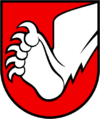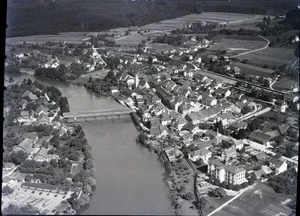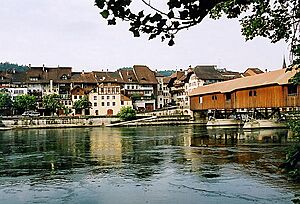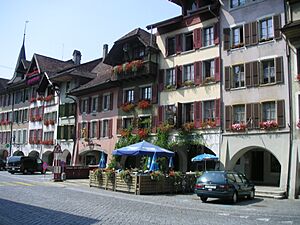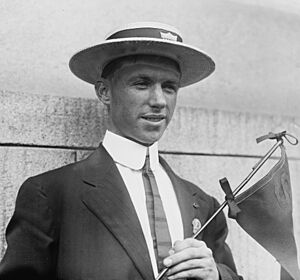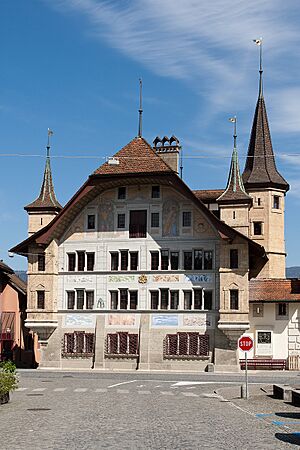Büren an der Aare facts for kids
Quick facts for kids
Büren a.A. / Büren an der Aare
|
||
|---|---|---|
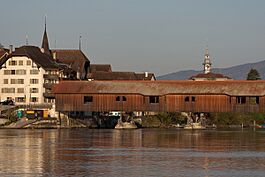
Büren with the historic wooden bridge spanning the Aare
|
||
|
||
| Country | Switzerland | |
| Canton | Bern | |
| District | Seeland | |
| Area | ||
| • Total | 12.6 km2 (4.9 sq mi) | |
| Elevation | 443 m (1,453 ft) | |
| Population
(Dec 2020 )
|
||
| • Total | 3,622 | |
| • Density | 287.5/km2 (744.5/sq mi) | |
| Postal code |
3294
|
|
| Surrounded by | Diessbach bei Büren, Dotzigen, Grenchen (SO), Lengnau, Meienried, Meinisberg, Oberwil bei Büren, Rüti bei Büren, Safnern, Schnottwil (SO) | |
Büren an der Aare (often called Büren a.A.) is a cool, old town in Switzerland. It's located in the canton of Bern, right by the Aare river. The name "Büren an der Aare" actually means "Büren on the Aare." It's a municipality in the Seeland administrative district.
Contents
History of Büren an der Aare
Büren an der Aare was first mentioned way back in 1185. It was called Buirro then. Later, in 1236, it was known as Buron. A nearby village, Reiben, joined Büren an der Aare in 1911.
Early Human Traces
People have lived in this area for a very long time. Scientists have found tools from the neolithic (New Stone Age) and La Tene periods. A Roman road used to run through here, connecting two important Roman towns. You can still find Roman ruins, like parts of the road and a milestone.
How the Town Grew
The town was built on a narrow piece of land between a hill and the Aare river. In 1260, Büren was given a special town charter. This meant it had certain rights and could grow. Over time, different powerful families controlled the area. In 1388, Bern and Solothurn took control of Büren. It then became the main town of a new area managed by Bern.
Büren Castle and the Church
From 1620 to 1625, Büren Castle was built. It was the official home for the Bernese bailiff, who was like a local governor. The oldest part of the town church, St. Catherine's, was built in the 1200s. The rest of the church was finished by 1500.
Trade and Economy
Büren was an important trading town. It had a market square and docks on the Aare river. This helped traders bring goods to Büren. They sold things like salt, iron, and wool. The town also had weekly markets and bigger fairs. Besides trade, farming was also important. In the 15th and 16th centuries, a new town hall was built. It even had a market hall on the ground floor! A hospital and school also opened in the 16th century.
Modern Times
In the 1800s, Büren faced some challenges. Major railway lines didn't pass through it, and river travel became less important. However, in 1876, a local railway line connected Büren to nearby towns. Some small factories, like watchmakers, opened here, but many have since closed. Today, there's an old gear factory and a meat processing plant. Newer companies, like those in electronics, have also moved in.
The Nidau-Büren channel, built in the late 1800s, helped protect the town from floods. It also created new farmland. Farming sugar beets and raising animals are still important. During World War II, Büren had the largest refugee camp in Switzerland. The famous wooden bridge was rebuilt in 1991 after a fire.
Geography of Büren an der Aare
Büren an der Aare covers an area of about 12.70 square kilometers (about 4.9 square miles). A large part of this land, about 46%, is used for farming. Forests cover about 34% of the area. About 11% of the land has buildings or roads. The rest is unproductive land, like rivers or lakes.
The town of Büren an der Aare is on the right side of the Aare river. The village of Reiben, which joined Büren, is on the left side. The municipality also includes small farming villages and newer neighborhoods.
Coat of Arms
The coat of arms for Büren an der Aare shows a bear paw coming out from the top left corner on a red background.
People of Büren an der Aare
Büren an der Aare has a population of about 3,600 people. Around 16% of the people living here are from other countries.
Age Groups and Households
- About 20% of the population are children and teenagers (0-19 years old).
- About 61% are adults (20-64 years old).
- About 17% are seniors (over 64 years old).
In 2014, there were about 1,500 households in Büren an der Aare. The average household had about 2.2 people. Most people in Büren an der Aare speak German as their main language. Some also speak Italian or French.
Population Changes Over Time
The population of Büren an der Aare has changed a lot over the years. You can see how it has grown and shrunk in the chart below:

Famous People from Büren an der Aare
Some notable people who were born or lived in Büren an der Aare include:
- Prof. Bernhard Studer (1794–1887) – a famous Swiss geologist.
- Ernst Pflüger (1846–1903) – a Swiss eye doctor.
- Gaston Strobino (1891–1969) – an American athlete who won a bronze medal in the marathon at the 1912 Summer Olympics.
- Markus Raetz (born 1941) – a Swiss painter, illustrator, and sculptor.
Important Heritage Sites
Büren Castle is a very important building in Switzerland. It's listed as a heritage site of national significance. Also, the entire old town of Büren an der Aare is considered a special heritage site.
Economy of Büren an der Aare
In 2013, about 1,893 people worked in Büren an der Aare.
- Some people work in the primary sector, which includes farming and forestry.
- Many people work in the secondary sector, which involves manufacturing (making things) and construction (building things).
- A lot of people work in the tertiary sector, which includes jobs like sales, transportation, hotels, restaurants, healthcare, and education.
In 2008, there were about 1,540 full-time jobs in the town. Many of these jobs were in manufacturing. People also worked in retail, transportation, hotels, and healthcare.
Religion
Most people in Büren an der Aare belong to the Swiss Reformed Church. A smaller number are Roman Catholic. There are also people who belong to other Christian churches, or are Islamic, Buddhist, or Hindu. Some people do not belong to any church.
Education
In Büren an der Aare, many adults have completed upper secondary education. Some have also gone on to higher education, like university.
School System
The Canton of Bern has a specific school system:
- First, there's one year of non-mandatory Kindergarten.
- Then, six years of Primary school.
- After that, three years of mandatory lower Secondary school. Students are grouped by their abilities.
- After lower Secondary, students can continue their education or start an apprenticeship (learning a trade).
During the 2009–10 school year, about 370 students attended schools in Büren an der Aare. There were classes for kindergarten, primary school, and lower secondary school.
Library
Büren an der Aare has a library called Bibliothek Büren. In 2008, it had over 7,700 books and other media. It loaned out more than 23,000 items that year!
See also
 In Spanish: Büren an der Aare para niños
In Spanish: Büren an der Aare para niños


